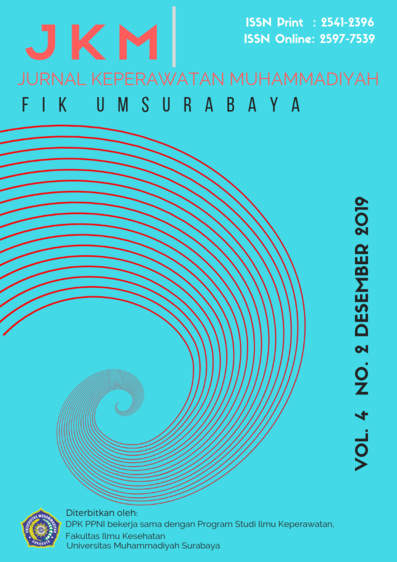Intervensi Diet Rendah Garam Pada Pada Pasien Yang Menjalani Hemodialisis: Review Literatur
DOI:
https://doi.org/10.30651/jkm.v4i2.3097Keywords:
dietary sodium, end stage renal disease, hemodialysis patientAbstract
Background: Application of low salt diet interventions to reduce health complaints and the risk of heart disease in hemodialysis patients.                                   Method: Search related articles through scientific publications by entering keywords in the PubMed, ScienceDirect, and Google Scholar databases       Results: From the 6 articles reviewed, the low salt diet intervention gave changes to systolic and diastolic blood pressure, provided a change in the level of sodium excretion, changes in quality of life and had self efficacy against salt reduction.  Conclusion: It is important for nurses, especially hemodialysis nurses, to optimize education regarding the importance of a low-salt diet of less than 2 grams per day through food and beverages consumed, or in the process of preparing and cooking food.
References
Causland, F. R., Walker, S. S., & Bnunelli, S. M. (2013). Increased dietary sodium is independently associated with greater mortality among prevalent hemodialysis patients. Magn Reson Imaging, 31(3), 477–479. https://doi.org/10.1016/j.immuni.2010.12.017.Two-stage
Clark-cutaia, M. N., Ren, D., Hoffman, L. A., Snetselaar, L., Sevick, M. A., Science, T., … Science, T. (2015). Psychometric Validation of the Self-Efficacy for Restricting Dietary Salt in Hemodialysis Scale Maya, 28(4), 384–391. https://doi.org/10.1097/01.TIN.0000437407.76867.65.Psychometric
Cutaia, M, N., Ren, D., Hoffman, L, A., Burke, L, E., & Sevick, M, A. (2013). Adherence to Hemodialysis Dietary Sodium Recommendations: Influence of Patient Characteristics, Self-Efficacy and Perceived Barriers. Magn Reson Imaging, 31(3), 477–479. https://doi.org/10.1016/j.immuni.2010.12.017.Two-stage
Deziel, C., Bouchard, J., Zellweger, M., & Madore, F. (2007). Impact of hemocontrol on hypertension, nursing interventions, and quality of life: A randomized, controlled trial. Clinical Journal of the American Society of Nephrology, 2(4), 661–668. https://doi.org/10.2215/CJN.04171206
Griva, K., Nandakumar, M., Ng, J. an H., Lam, K. F. Y., McBain, H., & Newman, S. P. (2018). Hemodialysis Self-management Intervention Randomized Trial (HED-SMART): A Practical Low-Intensity Intervention to Improve Adherence and Clinical Markers in Patients Receiving Hemodialysis. American Journal of Kidney Diseases, 71(3), 371–381. https://doi.org/10.1053/j.ajkd.2017.09.014
Hu, L., St-jules, D. E., Popp, C. J., & Sevick, M. A. (2018). Determinants and the Role of Self-Efficacy in a Sodium-Reduction Trial in Hemodialysis Patients. Journal of Renal Nutrition, 16–20. https://doi.org/10.1053/j.jrn.2018.10.006
Kementerian Kesehatan, R. I. (2019). Hindari hipertensi, konsumsi garam 1 sendok teh per hari, 1–2.
Kotanko, P., Garg, A. X., Depner, T., Pierratos, A., Chan, C. T., Levin, N. W., … Stokes, J. B. (2015). Effects of Frequent Hemodialysis on Blood Pressure: Results from the Randomized Frequent Hemodialysis Network Trials, 162(3), 561–567. https://doi.org/10.1016/j.jconrel.2012.07.004.Enhanced
Mary Ann Sevick, ScD, RN, Beth M. Piraino, MD, David E. St-Jules, RD, PhD, Linda J. Hough, MPH, Joseph T. Hanlon, PharmD, Zachary A. Marcum, PharmD, Susan L. Zickmund, PhD, Linda G. Snetselaar, PhD, RD, Ann R. Steenkiste, MS, and Roslyn A.Stone, P. (2016). No difference in average interdialytic weight gain observed in a randomized trial with a technology-supported behavioral intervention to reduce dietary sodium intake in adults undergoing maintenance hemodialysis in the United States: Primary outcomes of t, 26(3), 149–158. https://doi.org/10.1053/j.jrn.2015.11.006.No
Mason, B., Ross, L., Gill, E., Healy, H., Juffs, P., & Kark, A. (2014). Development and Validation of a Dietary Screening Tool for High Sodium Consumption in Australian Renal Patients. Journal of Renal Nutrition, 24(2), 123–134.e3. https://doi.org/10.1053/j.jrn.2013.10.004
Mcmahon, E. J., Bauer, J. D., & Campbell, K. L. (2018). A Randomized Trial of Dietary Sodium Restriction in CKD Effect of Dietary Sodium Restriction on Ambulatory BP and Other Outcomes, (Table 2), 1–8.
McManus, M. S., & Wynter-Minott, S. (2017). Guidelines for Chronic Kidney Disease: Defining, Staging, and Managing in Primary Care. Journal for Nurse Practitioners, 13(6), 400–410. https://doi.org/10.1016/j.nurpra.2017.04.017
Meuleman, Y., Hoekstra, T., Dekker, F. W., Navis, G., Vogt, L., van der Boog, P. J. M., … Prantl, K. (2017). Sodium Restriction in Patients With CKD: A Randomized Controlled Trial of Self-management Support. American Journal of Kidney Diseases, 69(5), 576–586. https://doi.org/10.1053/j.ajkd.2016.08.042
Moattari, M., Ebrahimi, M., Sharifi, N., & Rouzbeh, J. (2012). The effect of empowerment on the self-efficacy, quality of life and clinical and laboratory indicators of patients treated with hemodialysis: A randomized controlled trial. Health Qual Life Outcomes. 2012 , 20(10):115, 1–10.
Rocco, M., Daugirdas, J. T., Depner, T. A., Inrig, J., Mehrotra, R., Rocco, M. V., … Brereton, L. (2015). KDOQI Clinical Practice Guideline for Hemodialysis Adequacy: 2015 Update. American Journal of Kidney Diseases, 66(5), 884–930. https://doi.org/10.1053/j.ajkd.2015.07.015
Stats, F. (2017). Centers for Disease Control and Prevention. National Chronic Kidney Disease Fact Sheet, 2017, 1–4. Retrieved from https://www.cdc.gov/diabetes/pubs/pdf/kidney_factsheet.pdf
Tamaura, Y., Nishitani, M., Akamatsu, R., Tsunoda, N., Iwasawa, F., Fujiwara, K., … Sakai, T. (2018). Association Between Interdialytic Weight Gain, Perception About Dry Weight, and Dietary and Fluid Behaviors Based on Body Mass Index Among Patients on Hemodialysis. Journal of Renal Nutrition, 1–14. https://doi.org/10.1053/j.jrn.2018.04.009
Downloads
Published
Issue
Section
License
- Penulis tetap memegang hak atas karyanya dan memberikan hak publikasi pertama kepada jurnal ini yang secara simultan karya tersebut dilisensikan di bawah:Â Creative Commons Attribution-ShareAlike 4.0 International (CC BY-SA 4.0)













